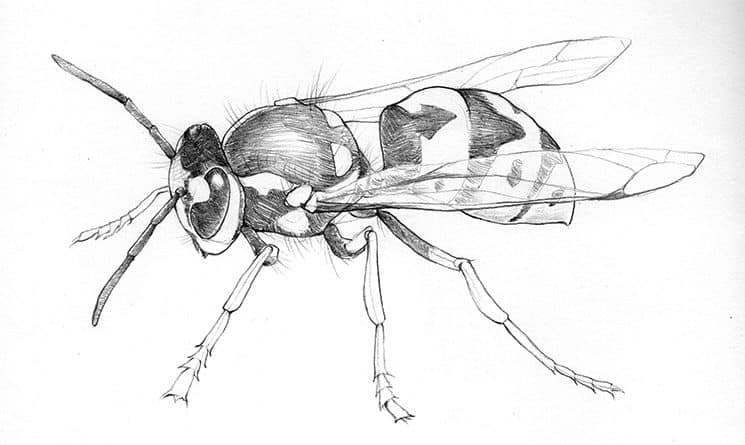Q: Where did all these wasps come from and what can I do about them?
Jeremy Delisle, Education Center Program Coordinator, UNH Cooperative Extension
Illustration by Alyssa Grenning
A: Over the past several weeks, we have had many calls concerning wasps. This is an annual occurrence each fall. Many of these calls have been about the wasps nests in the ground, near buildings, or in nearby trees. We spoke with George Hamilton, extension educator for Hillsborough County, to get his take on the situation.
We can loosely divide wasps into three groups: nonstinging, solitary nesters, and social nesters. Examples of nonstinging wasps are sawflies and insect parasites. Solitary nesting wasps will sting only if handled. Social nesting wasps will sting when the nest or individual feels threatened. While some social nesting wasps can be considered beneficial — by helping control pest insects — the aggressive nature of social wasps often makes them intolerable.
Each wasp nest starts new in the spring and is enlarged as the colony builds up to hundreds of individuals. The nest is largest in the autumn and is not reused the following year. Mated queens overwinter away from the nest in protected outside locations or in structures. A queen killed in the fall or early spring will eliminate an entire nest.
Preventing a problem with wasps is the best control measure. Sanitation is important; remove garbage frequently and keep tight lids on all trash receptacles. Be sure to pick up and dispose of over-ripe fruit and vegetables in the garden. Should a wasp fly near you, slowly raise your arms to protect your face and move slowly indoors or through bushes to escape. Rapid movement and striking at a wasp often provoke attacks. Also, remember that if a wasp gets into your automobile while driving, never panic. The wasp wants out of the car as much as you want the wasp out. Slowly pull over and open car windows and doors.
To control an established nest in a wall or in the open, find the nest entrance from a safe distance. The entrance of an aerial nest is usually near the bottom. After dark or before sunrise, spray into the nest entrance with a wasp and hornet aerosol. Never stand directly below a nest when treating as dying wasps may fall from the nest. Wasps are normally in the nest at night and cannot fly without light. If you use a flashlight, a red lens or red cellophane cover will prevent wasps from detecting it (insects cannot “see” red light). Otherwise, be prepared to switch it off if wasps begin to leave the nest. It is particularly safest during cool, wet weather such as after a rainstorm. Observe the nest for a day or two for further activity. If you see no live wasps, seal the entrance. Never seal the entrance before all wasps are dead. If wasps are still active, retreat with the aerosol. Wall nests are sometimes found some distance from where the wasps enter, which can make aerosols ineffective. Dusts are recommended if the aerosol fails after two applications.
For ground nests, dusts or liquids are most effective, and you should seal the entrance with moist soil after treating. Other types of wasps will build nests in cavities in the ground, in hollow logs, or under stones. You can quickly destroy offending nests by simply pouring a kettle of boiling water over them after dark.
Control individual wasps found indoors with a fly swatter or flying insect aerosol. Do not handle stunned or dead wasps with bare hands, as you may expose the wasp stinger.
But remember: wasps are not just a nuisance. They can be very valuable, as they feed on caterpillars, mosquitoes, and flies. Try to imagine the fly problem we might have without wasps.
Got a question? Call 877-398-4769 (Monday-Friday, 9 a.m. to 2 p.m.) or email answers@unh.edu.

